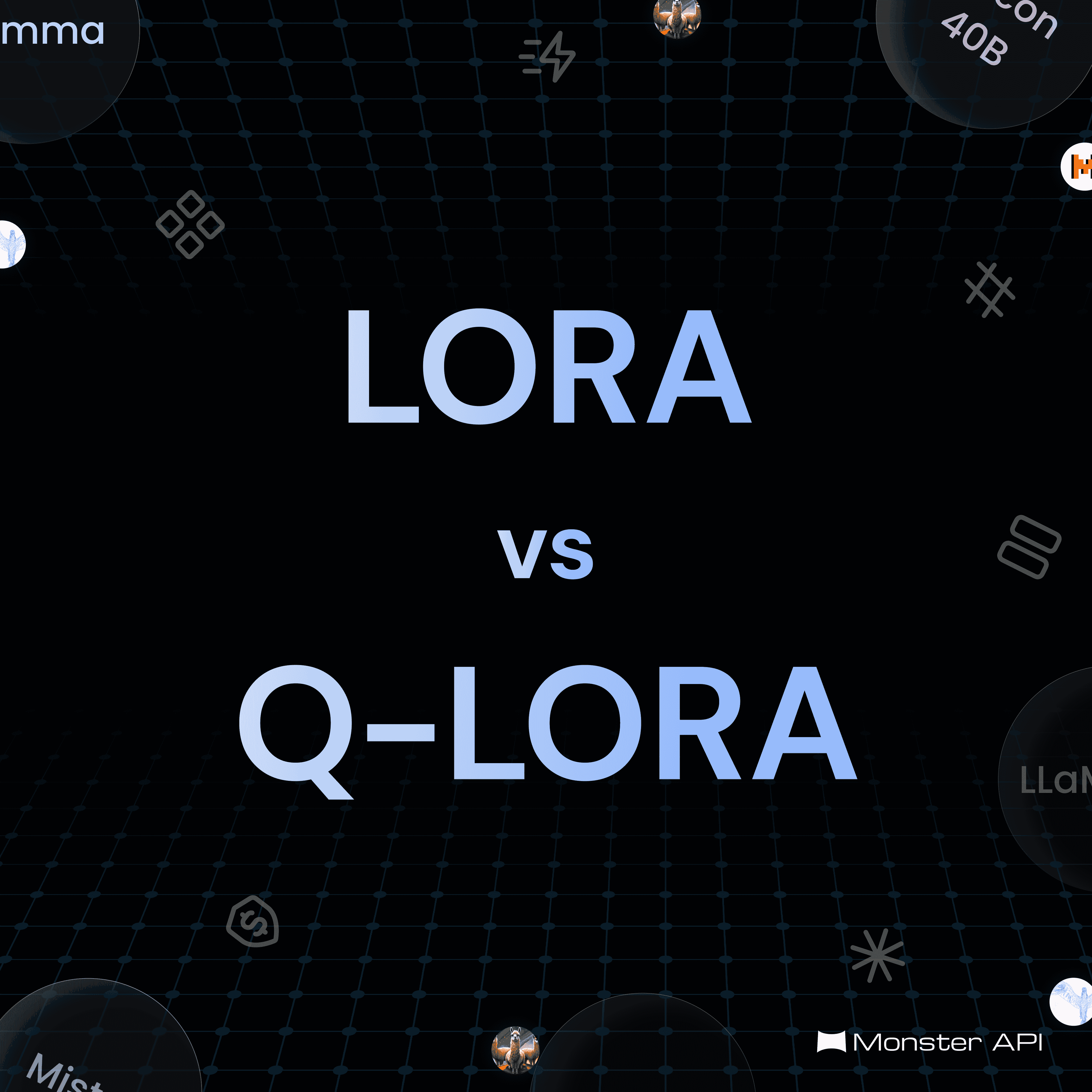What is LORA and Q-LORA Finetuning?
Low-Rank Adaptation (LoRA) and its variant, Quantized Low-Rank Adaptation (Q-LoRA)—significantly improve how LLMs are fine-tuned and deployed.

In the rapidly evolving landscape of AI, almost every month we see the release of SOTA open-source AI models and frameworks.
However, they often fail at domain-specific tasks and need to be adapted to our specific use case/dataset to perform better. Thus customization of AI models a.k.a. AI model fine-tuning becomes essential for achieving higher performance on our specific tasks.
Fine-tuning an AI model requires us to navigate the complex world of MLOps with many fine-tuning frameworks and configurations that are confusing and sometimes misleading.
To help you jump-start your journey in fine-tuning Large Language Models (LLMs), in this blog we are going to walk you through two advanced fine-tuning techniques—Low-Rank Adaptation (LoRA) and its variant, Quantized Low-Rank Adaptation (Q-LoRA)—that significantly improve how LLMs are refined and deployed.
Understanding LORA (Low-Rank Adaptation)
At its core, LoRA which stands for Low-Rank Adaptation, is an approach for efficient and effective adaptation of large pre-trained models to new tasks or domains without the need to retrain the entire model. This is crucial because training or fine-tuning large models like GPT-3, which has billions of parameters, is computationally expensive and resource-intensive.
This is achieved by introducing a low-rank decomposition into the weight matrices of the neural network. This allows for efficient parameter updates during the finetuning process, leading to significant savings in computational resources and time.
LoRA works by "injecting" trainable parameters into a pre-trained model in a way that does not require modifying all the original parameters of the model. Typically, when adapting a model to a new task, you might retrain many or all of the model's parameters (a process known as fine-tuning). This approach can be resource-intensive, especially for large models with billions of parameters.
Today, the fine-tuning of LLMs is mostly performed on GPUs which are costly, and fine-tuning all the model’s parameters results in the need for a higher quantity of GPUs with bigger memory size for speeding up the process thus full fine-tuning is quite costly. However, LoRA introduces a more efficient approach:
- Freeze the original weights: The original parameters of the model are kept unchanged.
- Introduce low-rank matrices: Instead of retraining the heavy parameters, LoRA adds small, trainable matrices that interact with the original weights to adapt the model to new tasks.
LORA decomposes the weight matrix \( W \) into two smaller matrices \( A \) and \( B \) such that \( W = AB \), where \( A \) and \( B \) have much lower ranks than \( W \). During finetuning, only the matrices \( A \) and \( B \) are updated while \( W \) remains fixed.
This decomposition significantly reduces the number of parameters that need to be learned during the finetuning process. For instance, if \( W \) is an \( m \times n \) matrix, its decomposition into \( A \) and \( B \) (where \( A \) is \( m \times r \) and \( B \) is \( r \times n \)) results in \( r(m + n) \) parameters instead of \( mn \), where \( r \) is the rank and \( r \ll \min(m, n) \).
Benefits of using LoRA
- Parameter Efficiency: By reducing the number of parameters to be updated, LORA decreases the computational cost and memory usage.
- Flexibility and Scalability: LORA allows for finetuning large models on relatively modest hardware, making advanced AI capabilities more accessible.
- Faster Training Speed: LoRA allows for quick adaptations to new tasks without the need for extensive retraining, making it ideal for scenarios where models need to be rapidly deployed across various tasks.
- No Additional Inference Latency: Unlike some other adaptation techniques that might increase the time it takes to generate predictions, LoRA does this without adding latency during the model's inference time.
Finetuning LLMs Using LoRA
Now that you know what LoRA is and its benefits for finetuning LLMs, let’s go over how to finetune an LLM using LoRA.
MonsterAPI provides a streamlined, no-code platform for finetuning large language models (LLMs) with LoRA (Low-Rank Adaptation). Here’s how the process works:
- Dataset validation and upload
To fine-tune an LLM, first and foremost, we need to validate whether the dataset format is valid or not.
MonsterAPI provides support for JSON, jsonl, parquet, CSV formats for dataset uploads and also supports HuggingFace dataset paths. So you can either directly pass the HF dataset path or upload your dataset on MonsterAPI platform.
- Specify model and hyperparameters
MonsterAPI provides a no-code and API implementation for specifying an LLM and hyperparameters for launching a finetuning job.To get started with MonsterTuner’s No-code UI, simply click on “Create new finetuning job” button on the LLM finetuning portal. Then specify a model such as Mistral 7B, Mixtral 8x7B, Llama 3 70B, Phi 3 etc.
MonsterAPI supports 40+ Open source models. Then specify the dataset path and hyperparameters such as LoRA R and Alpha values, number of epochs, early stopping patience etc. You may also choose to leave them as default and it would still perform very well.
Once finetuned, you’ll be able to download the finetuned LoRA adapter weights and deploy them either in your cloud or on MonsterAPI with the one-click LLM deployment engine - Monster Deploy.
That’s how easy it is to finetune LLMs using LoRA on MonsterAPI and deploy custom fine-tuned LoRA adapters as API endpoints.
You may also achieve the same result with MonsterAPI’s LLM finetuning API. Here’s a sample payload for launching a Mistral 7B finetuning job:
{
"pretrainedmodel_config": {
"model_path": "mistralai/Mistral-7B-v0.1",
"lora_r": 8,
"lora_alpha": 16,
"lora_dropout": 0,
"lora_bias": "none",
"use_quantization": false
},
"data_config": {
"data_path": "tatsu-lab/alpaca",
"data_subset": "default",
"prompt_template": "### Instruction: {instruction} ### Response: {output}",
"cutoff_len": 512,
"data_split_config": {
"train": 0.9,
"validation": 0.1
}
},
"training_config": {
"early_stopping_patience": 5,
"num_train_epochs": 5,
"gradient_accumulation_steps": 1,
"warmup_steps": 100,
"learning_rate": 0.0002,
"lr_scheduler_type": "reduce_lr_on_plateau",
"group_by_length": false
},
"logging_config": {
"use_wandb": false,
"wandb_username": "",
"wandb_login_key": "",
"wandb_project": "",
"wandb_run_name": ""
}
}
And then send this payload to this API endpoint with your Authentication key: https://api.monsterapi.ai/v1/finetune/llm
You may read in depth about our LLM finetuning docs or directly explore our LLM finetuning solution - MonsterTuner.
Exploring Q-LORA (Quantized Low-Rank Adaptation)
Q-LORA, or Quantized Low-Rank Adaptation, builds upon the principles of LORA by incorporating quantization into the fine-tuning process. Quantization involves representing the neural network weights with lower precision, typically using fewer bits.
This further reduces the memory footprint and computational requirements, enhancing the efficiency of the adaptation process for bigger-size AI models such as Large Language Models (LLMs).
What is Quantization?
Quantization is a process of reducing the precision of the numbers used to represent model weights. For instance, instead of storing weights as 32-bit floating points, you might store them using just 4 bits. This significant reduction in data size means that the model requires less memory, and computations can be executed more quickly and with less energy.
How Does Q-LORA Work?
Q-LORA integrates quantization into the low-rank adaptation process. After decomposing the weight matrix \( W \) into low-rank matrices \( A \) and \( B \), these matrices are quantized. For instance, instead of using 32-bit floating-point numbers, Q-LORA might use 8-bit integers to represent the weights.
The combination of low-rank decomposition and quantization leads to even more substantial reductions in model size and computational demands.
Quantization can be applied in various forms:
- Uniform Quantization: Maps the floating-point values to a fixed set of discrete values, evenly spaced.
- Non-Uniform Quantization: Uses a more complex mapping that may be more efficient for certain distributions of weight values.
Innovations in Q-LoRA
Q-LoRA introduces several technical innovations:
- 4-bit NormalFloat Quantization (NF4): This new data type is optimized for the normally distributed weights of neural networks, aiming to preserve as much information as possible even with reduced bit representation.
- Double Quantization: This technique further compresses the model by quantizing the quantization constants themselves, which are used to scale the weights back to their original range during computations.
- Paged Optimizers: To manage memory more efficiently during training, Q-LoRA uses techniques that temporarily move data between the GPU and CPU as needed, preventing out-of-memory errors.
Benefits of Q-LORA
- Further Efficiency Gains: The quantization step significantly reduces the memory footprint, making it feasible to deploy large models on edge devices or in environments with limited computational resources.
- Maintained Performance: Despite the reduced precision, Q-LORA can maintain model performance close to that of the full-precision models, thanks to careful quantization strategies.
- Cost Reduction: Lower computational requirements translate to reduced energy consumption and operational costs, an important factor for large-scale deployments.
Use Cases for LORA and Q-LORA
Low-Rank Adaptation (LoRA) and Quantized Low-Rank Adaptation (Q-LoRA) offer unique advantages in machine learning, particularly in the fine-tuning of large language models (LLMs). Their practical use cases span various domains, enhancing the accessibility and efficiency of model adaptation. Here’s how they can be applied in real-world scenarios:
- Natural Language Processing (NLP): Both LORA and Q-LORA are particularly beneficial for NLP tasks such as text classification, sentiment analysis, and machine translation, where pre-trained language models like BERT, GPT, and T5 are commonly used.
- Computer Vision: These techniques can be applied to fine-tune large vision models, enabling applications in image classification, object detection, and segmentation with reduced computational overhead.
- Edge Computing: By reducing the model size and computational requirements, LORA and Q-LORA facilitate the deployment of advanced AI models on edge devices like smartphones, IoT devices, and embedded systems.
- Multilingual Adaptation: Both techniques can be particularly effective for adapting models to multiple languages, allowing for localized applications of global models.
- Personalized AI Services: Companies can fine-tune general AI models to cater to individual user preferences or regional specifics, improving user experience in products such as digital assistants or personalized content recommendation systems.
Real-World Impact of LORA and Q-LORA
The advent of LORA and Q-LORA fine-tuning techniques has several far-reaching implications:
- Democratizing AI: By lowering the barrier to entry with cost and memory reduction, these techniques make powerful AI tools accessible to a broader range of users, including small businesses and researchers with limited resources.
- Environmental Impact: Reduced computational demands lead to lower energy consumption, contributing to more sustainable AI practices.
- Innovation Acceleration: Faster and more efficient finetuning allows for quicker experimentation and iteration, accelerating the pace of innovation in AI applications.
Conclusion
LORA and Q-LORA represent significant advancements in the field of model finetuning, offering efficient, scalable, and cost-effective solutions for adapting large neural networks.
By leveraging low-rank decomposition and quantization, these techniques address the critical challenges of computational and memory constraints, making advanced AI models more accessible and sustainable. As the field of AI continues to evolve, methods like LORA and Q-LORA will play a crucial role in enabling the next generation of intelligent systems.

